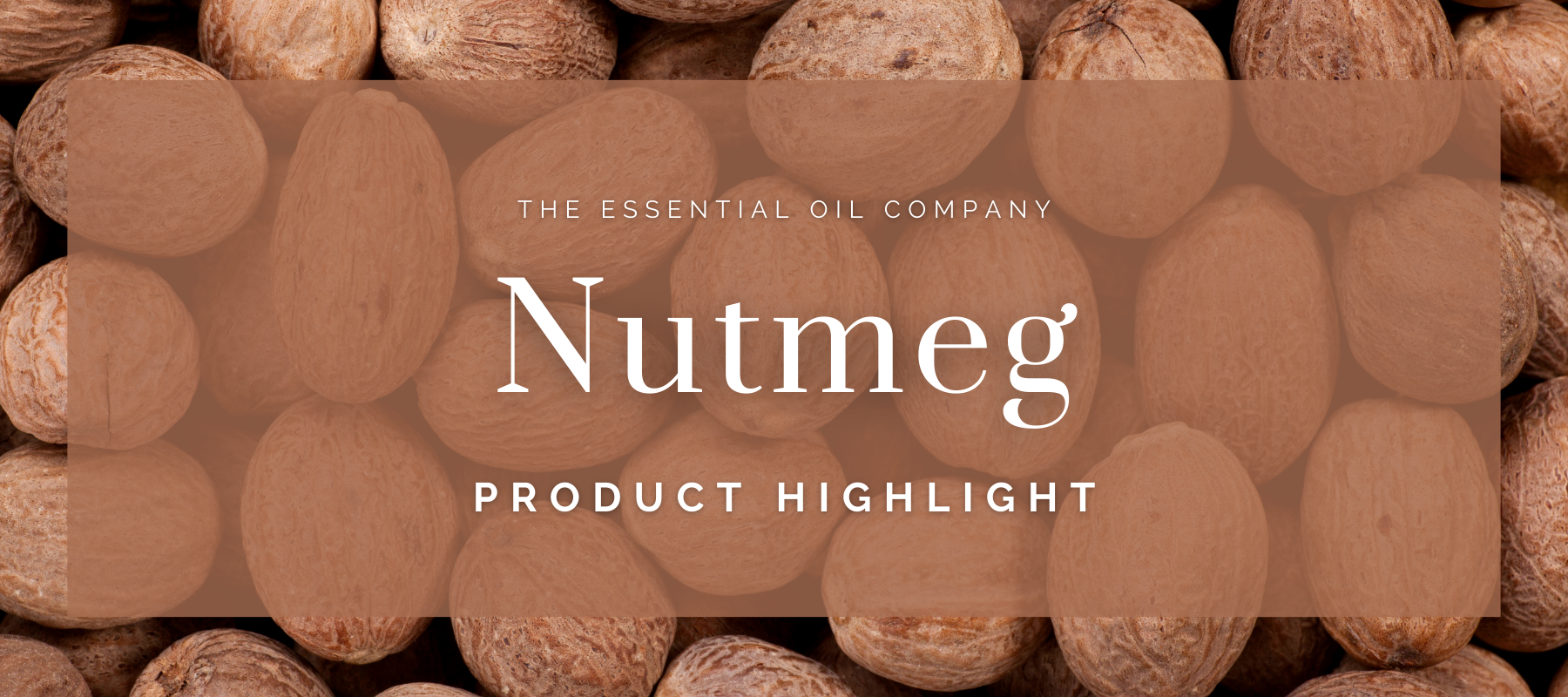
Nutmeg: Product Highlight
Plant Details
Nutmeg (Myristica fragrans) comes from the seed of a small evergreen tree in the Myristicaceae family. The tree is native to the Maluku Islands of Indonesia and can also be found growing in other areas of Indonesia, Malaysia, Sri Lanka, China, and India as well as parts of the Caribbean and South America. Nutmeg trees grow best in humid environments with warmer temperatures and high rainfall. The trees usually grow to between fifteen and fifty feet tall with some reaching over sixty feet in height. Nutmeg trees can spread six to twenty feet wide with an upright canopy of tiered branches. The leaves of the tree grow from two to six inches long and one to three inches wide and are arranged alternately along the branches. Nutmeg leaves are elliptic and leathery in texture with a rich dark green color and fragrant aroma. Nutmeg trees have the uncommon trait of being dioecious, meaning a single plant will bear either only staminate (male) or only carpellate (female) flowers. Very rarely does a single tree contain both types of flowers. Nutmeg trees have night-blooming flowers that are small, waxy, and bell-shaped, with a creamy white to pale yellow color. Staminate flowers grow in groups of one to ten, each reaching around a quarter of an inch long. Carpellate flowers are generally larger at half an inch long and grow solitarily or in small groups of around three. Carpellate Nutmeg trees produce small yellow pear-shaped fruits with a smooth exterior and fleshy husk. The husk of the fruit splits in half when ripe, revealing a purplish brown seed inside. Nutmeg seeds are around an inch long and glossy, covered with a bright red aril inside the fruit. The inner seed is the source of Nutmeg culinary spice and essential oil. The red aril, or seed covering, is the source of mace, another spice.
History
The name Nutmeg comes from the Old French term “nois muscade” and is likely derived from the Latin roots “nux” meaning nut, and “muscada” meaning musky. The name of the genus Myristica has a Greek origin meaning “ myrrh scented” and is inspired by the aromatic seeds and arils of the Nutmeg tree.
Beyond its culinary significance in many cultures, Nutmeg and its essential oil have held mystical allure and were believed to possess aphrodisiac and hypnotic powers. Nutmeg Essential Oil was used in China, India, and the Middle East to induce feelings of arousal, rekindle marriages, and aid with fertility. Myristicin, a primary component of the oil, led to claims that consuming Nutmeg could induce hallucinations, euphoria, and paranoia. Traditional medicine across cultures has embraced Nutmeg Essential Oil and used it heavily in their practices. Ancient China used it for liver and abdominal issues, while Indian Ayurvedic practitioners turned to it to address a variety of ailments. Even in ancient Egypt, Nutmeg Essential Oil played a role as a preservative in the embalming and mummification process.
Nutmeg trees originated in a secluded chain of islands in Indonesia. Arab traders were among the first to discover Nutmeg. To protect its source, they began telling stories and legends about its origins to lead other travelers and traders away from their find. As Nutmeg later made its way into European trade, it was an expensive delicacy affordable only to the elite. The Black Death pandemic further elevated its price when some medieval doctors claimed it to be the ultimate antidote to the plague. One of the most interesting chapters in Nutmeg's history unfolded during the 1600s with the infamous "Nutmeg Wars." The Dutch, in pursuit of a monopoly on Nutmeg production, initiated a devastating conflict on the Banda Islands, leading to the loss of a significant portion of the Bandanese population. The British would later transplant Nutmeg trees to various locations, including Sri Lanka and Singapore, temporarily taking control during the Napoleonic Wars.
The spice also left its mark on the United States. Connecticut earned its nickname, "the Nutmeg State," which stemmed from a historical narrative claiming that crafty traders from Connecticut sold "wooden Nutmegs" as a form of fraud. This is likely due to the fact that it was not widely known at the time that Nutmeg required grating to obtain the spice powder.
Extraction
Nutmeg trees can experience their initial harvest around seven years after planting and reach their full harvesting capacity after ten to twenty years. After the initial harvest time, the trees will begin to bear fruit throughout the year. Once harvested, the outer arils of the Nutmeg seeds are removed and the seeds are allowed to air dry in the sun for four to eight weeks. When dried, the seed kernels are isolated and transported for extraction. Nutmeg Essential Oil is extracted from the seed of the tree through steam distillation. The resulting essential oil is thin and clear with a soft, spicy, and woodsy aroma.
Benefits & Uses
When used in aromatherapy, Nutmeg Essential Oil is believed to promote relaxation and relieve feelings of stress. Its warm and comforting scent serves as a calming influence, helping the mind and body to unwind while inducing a sense of tranquility. Nutmeg Essential Oil has been found to elevate mood and recharge energy levels, working to alleviate fatigue and tension after a long day. It is also known to enhance mental clarity and alertness, making it a valuable ally for those seeking to improve concentration and focus.
When diluted and used topically, Nutmeg Essential Oil demonstrates its versatility with a range of benefits. It has been found to soothe sore muscles and provide relief from joint pain, making it useful in massage or targeted application after physical exertion or injury. Nutmeg Essential Oil may help to alleviate muscle cramps and spasms while also soothing tension and tenderness. Nutmeg is known to support digestive health, working to ease discomfort, particularly in cases of gas and bloating. Utilized in skincare, Nutmeg Essential Oil is thought to possess anti-inflammatory and antioxidant properties that may help to achieve a clear, radiant complexion. It is believed to soothe skin irritation and combat acne-causing bacteria, helping to improve skin tone and diminish the appearance of blemishes. Nutmeg Essential Oil may also improve hair health by supporting blood circulation to the scalp. This increased blood flow may help stimulate hair follicles to promote hair growth and strength. Nutmeg Essential Oil has been found to reduce dandruff and dryness, working to ease itchiness and maintain a healthy scalp. It is also believed to encourage hair shine and softness, helping to manage frizz and promote healthier-looking locks.
Here are some recipes using Nutmeg Essential Oil that we love...
Away from the Office Diffuser Blend
Ingredients
- 4 drops of Nutmeg Essential Oil
- 4 drops of Sweet Orange Essential Oil
- 3 drops of Ginger Essential Oil
Instructions
Add water to your diffuser up to the fill line. Add drops of the essential oil blend. This diffuser blend recipe is formulated for a 200ml ultrasonic diffuser. Adjust the amount according to the size and directions of your diffuser.

Soothing Serenity Foaming Bath Salts
Ingredients
- 1 cup of Course Sea Salt
- ½ cup of Epsom Salt
- 1 oz of Unscented Liquid Castile Soap
- 1/2 oz of Sweet Almond Oil
- 15 drops of Nutmeg Essential Oil
- 15 drops of Chamomile Essential Oil
- 15 drops of Lavender Essential Oil
Instructions
Add coarse sea salt and Epsom salt to a large bowl and mix thoroughly. Add castile soap, sweet almond oil, and essential oils to a small bowl and stir together until well combined. Add liquid mixture to salts and stir thoroughly until the mixture is fully incorporated and the salt seems to be evenly coated. Add about ½ cup to a warm bath and stir to dissolve.

Hydration & Strength Nourishing Hair Mask
Ingredients
- 2 oz of Unrefined Coconut Oil
- 2 oz of Sweet Almond Oil
- 1 oz of Unrefined Shea Butter
- 25 drops of Nutmeg Essential Oil
- 25 drops of Rosemary Essential Oil
- 25 drops of Clary Sage Essential Oil
Instructions
Add coconut oil, sweet almond oil, and shea butter to a bowl. Using an electric hand mixer, whip the oils together until a fluffy, creamy consistency is formed. Add essential oils and mix again until thoroughly combined. Scoop into an airtight container for storage. To use, apply a generous amount of the mask evenly throughout the hair. Massage it in from the roots to the tips then comb through your hair with your fingers. Leave the mask on for up to 20 minutes. Shampoo and condition hair as normal.

Calming Comfort Massage Oil
Ingredients
- 2 oz Amber Glass Bottle with Dropper Top
- 1 oz of Sweet Almond Oil
- 1/2 oz of Jojoba Oil
- 20 drops of Nutmeg Essential Oil
- 10 drops of Peppermint Essential Oil
- 10 drops of Lavender Essential Oil
- 10 drops of Black Pepper Essential Oil
Instructions
Add all ingredients to the amber glass bottle and shake vigorously to combine. Add several drops to your hands and massage into muscles to soothe aches and pains.

Merry & Bright Aromatherapy Spray
Ingredients
- 4 oz Amber Glass Bottle with Spray Top
- 2 oz of High Percentage Alcohol
- 2 oz of Distilled Water
- 10 drops of Nutmeg Essential Oil
- 10 drops of Frankincense Essential Oil
- 5 drops of Sweet Orange Essential Oil
Instructions
Add 2 ounces of high-percentage alcohol to the bottle. Add the essential oil blend and fill the remainder of the bottle with water, leaving a little space at the top. Shake well before each use. Spray around the home.






